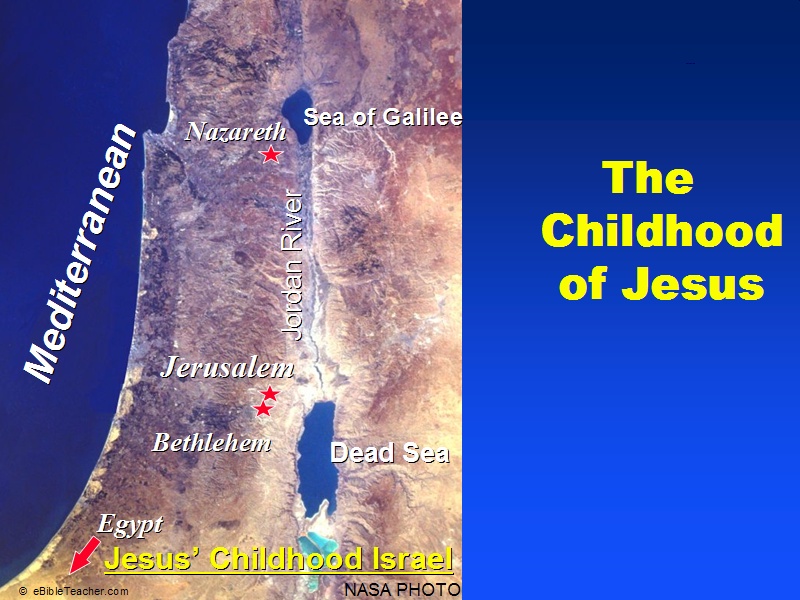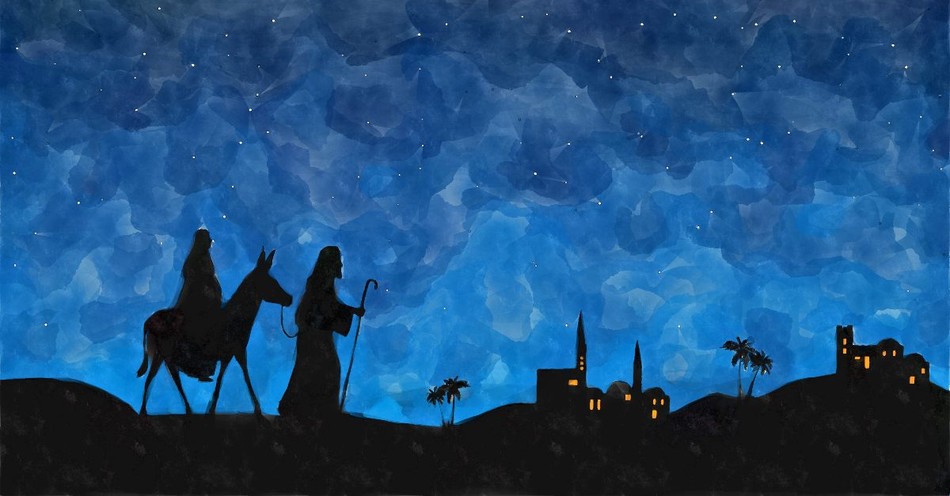"Now after Jesus was born in Bethlehem of Judea in the days of Herod the king, behold, wise men from the east came to Jerusalem, saying, "Where is he who has been born king of the Jews? For we saw his star when it rose and have come to worship him." (Matthew 2:1-2)
All around the world, we celebrate the birth of Jesus on December 25th, Christmas Day. The birthplace of Jesus is Bethlehem in Judea. But what do we really know about this town and location?
Quick Facts
- Bethlehem is 10 kilometers south of Jerusalem in Judea, a mountainous region iin the southeast corner of Palestine
- Mary and Joseph arrived in Bethlehem where the inns were full and they were given option to stay in a stable, where Jesus was born
- Bethlehem was the hometown of King David and the Old Testament prophecy states that the Messiah will be born "in the city of David"
- The first church built in Bethlehem was the Church of the Nativity, constructed in AD 327 during the reign of Emperor Constantine the Great.
What the Bible Says About Bethlehem, Where Jesus Was Born
The question of where Jesus was born is often answered with a city – Bethlehem. We know this from Biblical prophesies and narrative accounts like in Luke 2:4 and Matthew 2:1. But Bible scholars are less sure about specific details involving the setting. Again, we know from Luke’s gospel that Jesus was not born in an inn because there wasn’t room for his parents (Luke 2:7). Let's take a look at some key Scriptures that unfold the importance and details of Jesus' birth in Bethlehem.
“But you, Bethlehem, Ephrathah, though you are little among the thousands of Judah, yet out of you shall come forth to Me the One to be Ruler in Israel, whose goings forth are from of old, from everlasting.” - Micah 5:2
According to Micah 5:2 and Jewish tradition, the Messiah (the Christ) would be born in Bethlehem, a small town near Jerusalem. Luke 2 informs us that Mary and Joseph traveled to the town for a census prior to Jesus's birth, thus fulfilling the prophecy.
“Joseph also went up from Galilee, out of the city of Nazareth, into Judea, to the city of David, which is called Bethlehem, because he was of the house and lineage of David…And she brought forth her firstborn Son, and wrapped Him in swaddling cloths, and laid Him in a manger, because there was no room for them in the inn.” - Luke 2:4-7
The Gospel account of Luke informs us that Mary and Joseph traveled to the town for a census prior to Jesus's birth, thus fulfilling the prophecy.
“Now after Jesus was born in Bethlehem in the days of Herod the king, behold, wise men from the East came to Jerusalem, saying, ‘Where is He who has been born King of the Jews? For we have seen His star in the East and have come to worship Him.’” - Matthew 2:1-2
After Jesus' birth in Bethlehem, wise men (Magi) from the East arrive in Jerusalem seeking the "King of the Jews." They were guided by a unique star they had seen in the East, which they interpreted as a celestial sign of the Messiah's birth. Likely skilled in astrology and ancient prophecies, the Magi connected the appearance of the star with Jewish messianic expectations, prompting them to travel to Israel to worship this newborn King, ultimately leading them to Bethlehem.
“When the angels had left them and gone into heaven, the shepherds said to one another, ‘Let’s go to Bethlehem and see this thing that has happened, which the Lord has told us about.’” - Luke 2:15
The fields where the shepherds watched their flocks were likely located just outside of Bethlehem. Bethlehem, a small town in Judea, had open fields in its surrounding area suitable for grazing sheep. These fields, possibly located on the outskirts of the town, provided a setting for the shepherds' nighttime encounter with the angels. Traditionally, some of these fields have been marked as significant sites, such as the "Shepherds' Field," where modern-day visitors can imagine the historical and biblical scene.
“He contacted the Magi secretly and found out from them the exact time the star had appeared. He sent them to Bethlehem and said, ‘Go and search carefully for the child. As soon as you find him, report to me, so that I too may go and worship him.’” - Matthew 2:7-8
In this verse (Matthew 2:7-8), King Herod secretly meets with the Magi to gather information about the star that signified Jesus' birth. He pretends to be interested in worshiping the child himself and instructs the Magi to find the child in Bethlehem, then report back to him. In reality, Herod's intentions were sinister, as he wanted to eliminate this potential rival for the throne. This led to the Magi's journey to Bethlehem, where they found Jesus, but they later avoided returning to Herod due to a divine warning.
After the Magi did not return to Herod, he realized he had been outwitted. In response, Herod ordered the massacre of all male children two years old and under in Bethlehem and its surrounding areas. This tragic event, known as the "Massacre of the Innocents," was Herod’s attempt to kill Jesus, whom he saw as a threat to his throne. The age range he targeted was based on the information he had gathered from the Magi about the time the star had appeared (Matthew 2:16).

*Used by permission of eBibleTeacher.com
What Else Do We Know about Bethlehem?
Bethlehem, a small and historically significant city, is nestled in the West Bank region of modern-day Palestine. The name "Bethlehem" itself translates to "House of Bread" in Hebrew, emphasizing its agricultural importance in ancient times.
In addition to the Gospels of Matthew and Luke providing accounts of Jesus's birth in Bethlehem, Bethlehem is also prominently mentioned in the Old Testament as the hometown of King David, the celebrated psalmist and shepherd-king of Israel. This connection to David's lineage is significant in the New Testament as it fulfills the prophecy that the Messiah would be born in the "city of David." Thus, Bethlehem's role as the birthplace of Jesus is deeply rooted in biblical prophecy, specifically in the book of Micah.
Today, Bethlehem remains a major pilgrimage site for Christians from around the globe. The town is rich in history and offers insights into early Jewish and Christian traditions, making it a profound place for reflection. Pilgrims visit to honor the nativity story, exploring various sites and archaeological finds that deepen the understanding of Bethlehem’s spiritual legacy.
Was Jesus Born in a Cave, Home, or Stable?
When we think about the nativity scene, many of us picture Jesus being born in a humble stable, surrounded by animals. This image, deeply ingrained in our Christmas traditions, comes from the Gospel of Luke. In Luke 2:7, we're told that Mary "laid him in a manger because there was no room for them in the inn." A manger, after all, is a feeding trough for animals, which implies that Jesus was born in a place where animals were kept.
Yet, the Bible doesn't give us a detailed description of the exact location. Over time, the stable scene has become a staple of Nativity displays and Christmas imagery. However, some early church writings suggest another possibility: Jesus might have been born in a cave. In ancient Bethlehem, caves were often used as shelters for animals, providing protection from the harsh elements and keeping livestock warm during the cold winters.
Alternatively, there's a scholarly perspective that Jesus could have been born in a home that included a designated area for animals. In those times, homes often had spaces for livestock, so the phrase “there was no room for them in the inn” might hint at a more communal living arrangement. This view aligns with the humble nature of Jesus's birth, suggesting a setting that was both modest and accessible.
Regardless of whether Jesus was born in a stable, a cave, or a home with an animal area, the nativity story underscores the humility and grace of His arrival. It serves as a powerful reminder of simplicity and hope, resonating with the broader biblical themes of inclusivity and divine grace that mark His entrance into the world.
When Was Jesus Born?
The traditional date of December 25 goes back to the early centuries of the Christian era. Contrary to what some have asserted, there is no evidence that Christians “borrowed” that date from a pagan festival honoring the sun. William J. Tighe argues that the reverse is more likely to be true:
“Rather, the pagan festival of the “Birth of the Unconquered Son” instituted by the Roman Emperor Aurelian on 25 December 274, was almost certainly an attempt to create a pagan alternative to a date that was already of some significance to Roman Christians. Thus the “pagan origins of Christmas” is a myth without historical substance.”
In regards to the actual time of year for Jesus’ birth, the Bible states in Luke 2:8-9: “Now there were in the same country shepherds living out in the fields, keeping watch over their flock by night. And behold, an angel of the Lord stood before them, and the glory of the Lord shone around them, and they were greatly afraid.”
According to biblical scholar Adam Clarke, it was traditional for the shepherds of that region to send their sheep to the field from the spring until the beginning of October. As the colder winter months started, the flocks would return from the pastures for refuge and warmth. Because the shepherds were still guarding their flocks in the fields near Bethlehem, it can be inferred that the angels proclaimed the message of Jesus’ birth in October at the latest.
Read more: When Was Jesus Actually Born?
Additional FAQ on the Birth of Jesus
Why is Christmas on December 25th?
Scholars suggest the Roman Catholic Church decided on Dec. 25 for various reasons, such as that date's links to the winter solstice and Saturnalia, a festival devoted to the Roman deity Saturn. The Encyclopedia Britannica says that church leaders likely selected it “to coincide with the pagan Roman festival marking the birthday of the unconquered sun,” at the time of the winter solstice. According to The Encyclopedia Americana, many researchers believe this was done “to make Christianity more meaningful to pagan converts.”
What prophecies foretold the birth of Jesus?
Prophecies such as Micah 5:2 (about Bethlehem) and Isaiah 7:14 (a virgin bearing a son) foretold Jesus’ birth, pointing to the Messiah’s arrival.
Why was Jesus born in Bethlehem?
Jesus was born in Bethlehem to fulfill the prophecy in Micah 5:2, which said the Messiah would come from David’s city.
What was the significance of the manger in Jesus' birth?
The manger symbolizes humility and Jesus’ identification with the poor, showing He came for all people.
What role did the shepherds play in the nativity story?
The shepherds were the first to receive the announcement of Jesus’ birth, representing God’s message of salvation to the humble and lowly.
What was the political climate during Jesus' birth?
Jesus was born during the reign of Herod the Great under Roman rule. The political tension in Judea included expectations of a Messiah to liberate the Jewish people.
This article quotes from Was Jesus Really Born on December 25? , Was There Really a Consensus When Jesus was Born? & Was Jesus Really Born in a Cave? on Christianity.com
Related Video:
Photo Credit: ©iStock/Getty Images Plus/lukbar
This article is part of our larger Christmas and Advent resource library centered around the events leading up to the birth of Jesus Christ. We hope these articles help you understand the meaning and story behind important Christian holidays and dates and encourage you as you take time to reflect on all that God has done for us through His Son, Jesus Christ!
What Is Advent: Meaning, History, and Traditions
Advent Prayers for Friends, Family, and More
What Is an Advent Wreath and How to Use One?
The History of Santa Claus: Origin of St. Nicholas
Christmas Bible Verses & Scripture Story
What is Christmas? True Meaning and Holiday History
Christmas Eve History and Traditions
Why Gold, Frankincense, and Myrrh?
When Was Jesus Born? Why December 25th
Where Was Jesus Born?




.jpg)